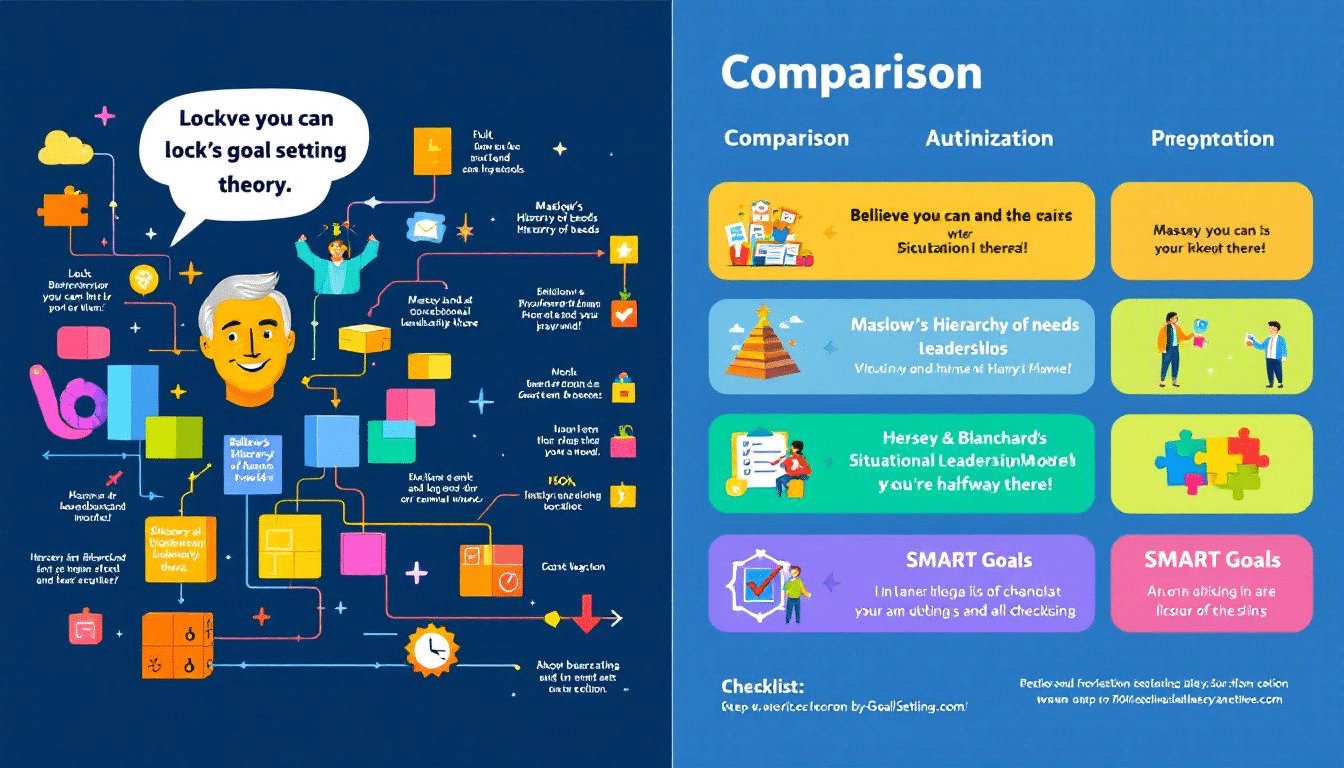Locke’s goal setting theory is a framework that emphasizes the importance of setting specific and challenging goals to enhance performance and motivation. This article explores the core principles of Locke’s theory and provides practical applications for various settings, such as workplaces, educational environments, and personal development. By understanding and implementing these principles, you can effectively boost productivity and achieve your objectives.
Key Takeaways
-
Set specific and challenging goals for enhanced motivation and performance, transforming aspirations into actionable plans.
-
Utilize the five key principles of goal setting: clarity, challenge, commitment, feedback, and complexity to improve success rates.
-
Apply goal setting effectively across various domains—workplace, education, and personal life—to unlock full potential and achieve remarkable outcomes.
Understanding Locke’s Goal Setting Theory

At its core, Locke’s Goal Setting Theory is founded on the premise that well-defined goals lead to enhanced performance. This theory has been recognized as one of the most impactful frameworks in motivational psychology, emphasizing the significance of goal specificity and difficulty to drive effective motivation. Setting specific and challenging goals helps individuals improve task motivation and performance, resulting in higher success levels across various domains.
The essence of Locke’s theory lies in its ability to transform vague aspirations into actionable plans, illustrating a practically useful theory. Specific goals with attainable action items enhance the likelihood of success.
Moreover, Locke emphasizes the importance of the learning process alongside performance, which is vital in motivation. A clear vision helps avoid elusive goals, ensuring each step is purposeful and directed towards meaningful outcomes.
Key Principles of Locke’s Goal Setting Theory
Understanding the five key principles of Locke’s Goal Setting Theory—clarity, challenge, commitment, feedback, and complexity—is crucial for harnessing its power. These principles form the backbone of effective goal setting, guiding individuals to create goals that are not only specific and challenging but also realistic and achievable.
Each principle plays a unique role in successful goal setting.
Clarity
Clarity in goal setting is paramount. Clear and specific goals act as a roadmap, guiding actions and decisions while reducing misunderstandings and enhancing performance. Specific goals offer measurable targets, minimizing ambiguity and leading to better performance outcomes. This clarity helps individuals stay focused and ensures that every effort is aligned with the desired outcome.
Using goal-setting templates and defining success criteria explicitly helps achieve clarity in goal setting. This structured approach aids in setting precise objectives, tracking progress, and making necessary adjustments. Clear goals provide a better understanding of required actions, fostering higher performance and achievement.
Challenge
The challenge is another crucial principle in Locke’s Goal Setting Theory. Challenging goals push individuals to go beyond their comfort zones, increasing motivation and enhancing overall performance. Higher goals boost motivation, encouraging harder work and greater achievement. Balancing challenge and realism is crucial to avoid frustration and promote growth while pursuing a challenging learning goal.
Realistic and attainable goals enhance the likelihood of achievement and teach valuable lessons on self-efficacy. Conversely, setting unrealistic goals can lead to miscommunication, dissatisfaction, and affected performance. Goals need to be challenging enough to inspire effort but realistic enough to be attainable.
In sports, higher goals improve motivation, practice effort, and understanding of the game. Specific and challenging goals encourage individuals to push themselves, achieving more than they initially thought possible. Overly challenging goals may create mental pressure and overwhelm, potentially leading to failure.
Commitment
Commitment aligns individuals with their goals, making it crucial for success. When people are committed to their goals, they invest the necessary time and effort to achieve them. This dedication is often influenced by factors such as ability, feedback, and the level of goal commitment.
Accountability and writing down goals significantly boost commitment to achieving self-set goals. This sense of accountability can come from various sources, including peer support, mentorship, and personal reflection.
Strong commitment helps individuals stay focused and motivated throughout the goal-setting process.
Feedback
Feedback plays a pivotal role in the goal-setting process, helping individuals track their progress and make necessary adjustments to achieve their objectives. Regular feedback helps individuals evaluate their efforts and strategies, ensuring they stay on the right path towards goal attainment. A reliable feedback system is essential for maintaining motivation and accountability.
Effective feedback significantly impacts employee performance, directing them towards higher achievement and progress. Without feedback, team members may feel disconnected and unsure about their contributions, hindering the achievement of goals.
Establishing a solid feedback system is crucial for successful goal setting.
Task Complexity
Task complexity is an important consideration in goal setting. Goals perceived as too complex should be broken down into smaller, manageable tasks to maintain motivation and confidence. Overly complex goals can reduce the chances of achievement and may lead to overwhelm.
Locke’s theory suggests that balancing task complexity is key to preventing overwhelm and maintaining motivation. Breaking down complex tasks allows individuals to approach their goals with a clear plan, making progress tracking and success easier. This approach is particularly useful in organizational settings with intricate and multifaceted tasks.
Practical Applications of Goal Setting Theory

Locke’s Goal Setting Theory is not just a theoretical framework; it has practical applications that can significantly enhance motivation and performance in various settings. The principles of goal setting can be applied in the workplace, educational environments, and personal life to achieve remarkable outcomes.
Understanding and implementing these principles helps individuals and organizations unlock their full potential and achieve desired goals.
Workplace Motivation
In the workplace, specific and challenging goals are essential for enhancing employee motivation and engagement. Effective goal setting improves job satisfaction, overall productivity, and a sense of accomplishment among employees. Engaging employees in the goal-setting process fosters commitment and increases the likelihood of success.
Managers who set specific goals for their teams have reported enhanced performance outcomes. Successful onboarding using goal-setting theory involves setting specific, challenging objectives, such as mastering new software within a set timeframe. This approach helps new employees integrate into the organization and boosts their confidence and motivation.
In team projects, defining clear deadlines and breaking down tasks can enhance motivation and help meet project completion goals. Specific and challenging goals help teams stay focused, track progress, and achieve higher performance levels. This approach improves individual performance and fosters a collaborative and motivated work environment.
Educational Settings
Using well-defined goals in educational settings can significantly boost student engagement and academic outcomes. Clear and specific goals improve learning outcomes among students, helping them focus their efforts and achieve better results. A study involving medical students demonstrated that goal-setting improved surgical skills acquisition.
In academic settings, specific goals help students concentrate on tasks, leading to better writing and language acquisition. Commitment to these goals helps students navigate challenges, fostering a growth mindset and continuous improvement.
Personal Goals
Setting personal goals is crucial for creating focus and direction in one’s life. Without goals, individuals may experience indecision and lack of motivation, potentially leading to symptoms of depression. Specifically written goals provide structure, purpose, and meaning, enhancing the ability to achieve personal aspirations.
Clear and challenging personal goals help individuals stay motivated and track progress towards meaningful outcomes. This approach boosts self-efficacy and provides a sense of accomplishment and satisfaction in daily life.
Research and Case Studies on Goal Setting

Research and case studies robustly support the effectiveness of Locke’s Goal Setting Theory. Numerous studies show that specific and challenging goals improve task performance and motivation.
These findings highlight the practical utility of goal-setting principles across business, education, and personal development.
Notable Studies
Specific and challenging goals significantly enhance task performance compared to vague ones. Research indicates that clearly defined, challenging goals often lead to higher performance levels. In sports, athletes who set goals and use goal strategies tend to perform better, demonstrating the effectiveness of goal setting in enhancing motivation and performance.
Studies across various domains support the effectiveness of goal setting on motivation and performance. These studies underscore the importance of specificity and challenge in achieving higher performance levels, making goal setting valuable in various fields.
Real-World Examples
Case studies illustrate how Locke’s Goal Setting Theory is applied across various fields. A key business case study demonstrated that a company improved sales by setting specific, measurable goals for its sales team, leading to increased motivation and performance.
Case studies reveal that schools implementing specific academic goals for students saw a significant increase in student engagement and achievements.
Multiple case studies across various fields show that organizations adopting Locke’s goal-setting framework often achieve higher levels of motivation and task completion.
Comparing Locke’s Theory with Other Goal-Setting Frameworks

Locke’s Goal Setting Theory effectively motivates individuals through specific and challenging goals, but comparing it with other frameworks helps evaluate its effectiveness.
Understanding the nuances of different goal-setting approaches helps individuals and organizations choose the best strategies for their unique needs.
SMART Goals
The SMART Goals framework emphasizes Specific, Measurable, Achievable, Relevant, and Time-bound criteria, differing from Locke’s focus on challenging and specific tasks for motivation. While SMART goals offer clarity and structure, Locke’s emphasis on intrinsic motivation from meaningful goals may lead to deeper engagement.
SMART goals provide a defined structure for goal setting, emphasizing the importance of specificity and measurability. Locke’s theory emphasizes intrinsic motivation, which can lead to more sustained efforts towards achieving goals.
Expectancy Theory
Expectancy Theory, proposed by Vroom, addresses individual perceptions and value systems, complementing Locke’s Goal Setting Theory. This theory emphasizes individual beliefs about the relationship between effort and performance, differing from Locke’s focus on external goal clarity. Understanding how personal beliefs influence motivation, Expectancy Theory provides additional insights into the goal-setting process.
Vroom’s Expectancy Theory suggests that personal beliefs about the likelihood of success influence individual outcomes. It identifies three main factors: expectancy, instrumentality, and valence. Effective goal setting according to Locke and Vroom results in tailored goals that align with subjective needs and capacities, enhancing motivation and performance.
Enhancing Self-Efficacy through Goal Setting
Specific and challenging goals increase motivation and improve self-efficacy, leading to better performance outcomes. When individuals set realistic and attainable goals, achieving them reinforces their confidence in their abilities. This confidence, in turn, fuels further motivation and a greater sense of self-efficacy.
A supportive network provides motivation and accountability, helping individuals stay on track with their goals. Surrounding oneself with encouraging peers, mentors, or coaches makes the journey towards achieving goals more manageable and fulfilling.
This holistic approach to personal goal setting boosts performance and nurtures personal growth and resilience.
Overcoming Challenges in Goal Setting
Despite the benefits of goal setting, various challenges can impede progress. Addressing these challenges is crucial for successful goal attainment. Managing task complexity and maintaining mental health are key to overcoming obstacles and ensuring effective and sustainable goal setting.
Addressing Unethical Behavior
Unrealistic goals create immense pressure, potentially leading to unethical behavior among employees. The stress of achieving unattainable goals can prompt individuals to engage in unethical practices to meet expectations. To prevent this, organizations should focus on setting clear, achievable goals that encourage ethical decision-making.
Promoting a culture of realistic goal setting helps organizations mitigate the risk of unethical behavior and foster a more positive and productive work environment. This approach protects organizational behavior and supports employee well-being, ensuring long-term success.
Managing Mental Health
Balancing goal pursuit with mental well-being avoids burnout and stress. Goal pursuit without balance can lead to burnout, increased stress, and anxiety. Mindful goal setting with consideration for mental health supports well-being and reduces stress.
A mindful approach to goal setting involves realistic timelines, taking breaks, and practicing self-care. This balance ensures goal pursuit remains a positive and enriching experience, rather than a source of stress and burnout.
Implementing Goal-Setting Theory in Organizations

Implementing goal-setting theory in organizations involves strategic planning and effective communication. Providing clear metrics and timelines helps individuals understand and track their progress. Effective feedback during goal achievement maintains motivation and ensures individuals feel supported.
Achieving all five key principles of goal setting results in a higher-performing workplace and enhances subsequent performance.
Leadership Strategies
Involving team members in the goal-setting process boosts their performance and commitment to achieving those goals. Regular communication and detailed feedback are essential for keeping teams aligned and motivated. Setting ambitious goals can enhance employee feelings of value, thereby increasing their motivation and ownership.
Utilizing tools like ClickUp to create trackable goals ensures that progress can be effectively monitored and aligned with organizational expectations. These strategies not only improve individual performance but also foster a collaborative and motivated work environment.
Tools and Resources
Goal-setting empowers decision-making and helps filter what’s significant. A clear roadmap helps employees plan challenging tasks and allows managers to track progress. ClickUp is a recommended tool for goal setting in organizations, helping manage goals by connecting targets to work/team goals and tracking progress.
Using goal-setting templates in ClickUp streamlines the goal-setting process. The Goals Signals Measures Template by ClickUp outlines the definitions of goals, signals, and measures. It serves as a framework for assessing success. Integrating goals into team objectives allows for better tracking and management of progress.
Summary
Locke’s Goal Setting Theory offers a powerful framework for enhancing motivation and performance. By focusing on clarity, challenge, commitment, feedback, and complexity, individuals and organizations can set effective goals that drive success. Practical applications in the workplace, educational settings, and personal life demonstrate the theory’s versatility and effectiveness.
Incorporating goal-setting principles into daily life can transform aspirations into achievable milestones. Whether you’re aiming for career advancement, academic excellence, or personal growth, the strategies outlined in this guide provide a roadmap to unlock your true potential. Embrace the power of goal setting and embark on a journey towards greater achievement and fulfillment.
FAQ
What is the core principle of Locke’s Goal Setting Theory?
Locke’s Goal Setting Theory emphasizes that setting specific and challenging goals boosts performance and motivation. Embrace this principle to elevate your achievements and unlock your full potential!
How does goal clarity affect performance?
Clear goals boost performance by minimizing confusion and providing a focused path with measurable targets. Embrace goal clarity to unlock your full potential!
What role does feedback play in goal setting?
Feedback is crucial in goal setting as it helps you track your progress, make adjustments, and stay motivated. Embrace it to enhance your journey toward achieving your goals!
How can unrealistic goals lead to unethical behavior?
Unrealistic goals can drive people to compromise their principles under pressure, leading to unethical behavior. Instead, aim for achievable goals that promote integrity and ethical choices!
What are some tools recommended for goal setting in organizations?
ClickUp is a fantastic tool for goal setting in organizations, as it provides templates and tracking features to help you streamline your process and monitor your progress effectively! Embrace this tool to elevate your team’s goals!
